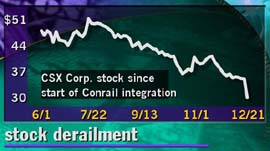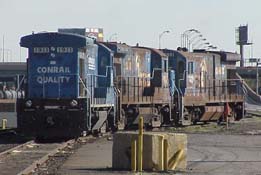|
4Q views derails CSX stock
|
 |
December 21, 1999: 2:11 p.m. ET
Railroad warns 4Q earnings worse than expected; analysts doubt quick recovery
By Staff Writer Chris Isidore
|
NEW YORK (CNNfn) - CSX Corp. stock plunged Tuesday after the company warned Monday night that its difficult fourth quarter would be much worse than expected, and analysts expressed doubt about executives' assurances that the company soon would put its problems behind it.
The stock opened Tuesday at 29-1/8, down 5-1/8, or 15 percent, from the Monday close of 34-1/4. It recovered some of that loss in morning trading, but was still down 4-1/2, or 13 percent, to 29-3/4 in early afternoon trade.
CSX (CSX) said Monday that it expected earnings in the quarter of between 18 and 24 cents a diluted share. Analysts surveyed by First Call had been expecting 53 cents a share before the warning. The company blamed problems with the integration of Conrail into its system and losses from its recently sold international ship line Sea-Land Service Inc.

While the news of continued problems at CSX did not surprise investors or analysts, the extent of the difficulties surprised even some critics. And while the company insisted that the worst of its problems should be behind it next year, three of the analysts who lowered their fourth-quarter estimates Tuesday also knocked down their estimates for 2000.
"Essentially the song remains the same if not sadder," said Terry Gardner, analyst at Deutsche Banc Alex. Brown, who had cut his earnings estimate for the quarter to 35 cents a share only last week, and lowered his estimate for the quarter and for 2000 again Tuesday. "We're watching the operational statistics very closely. We're trying to find the bottom in earnings. Apparently we haven't found it yet."
As recently as September the estimate for the quarter had been 70 cents a share. But when the Richmond, Va.-based company reported better-than-expected third-quarter earnings in October, it also warned that problems were developing in the fourth quarter.
Conrail integration problems linger
Monday's announcement shows that problems continue integrating the assets of Conrail, the former government-owned freight railroad, which was split between CSX and Norfolk Southern Corp. (NSC) last year.
"Earnings have suffered this quarter and throughout the year as we have changed the composition of our company and implemented the most complex rail merger in history," said a statement from John Snow, chairman and chief executive of CSX. "We had difficulty handling strong fourth-quarter demand and changing traffic flows, particularly in the northwestern sector of our new, combined rail network. As a result of this congestion, locomotive, equipment and crew costs were much higher than we expected."
CSX and Norfolk divided the assets of Conrail and integrated those assets into their systems June 1. Both have suffered service problems since then with delays, poor equipment utilization and expenditures on other modes to meet service guaranteed to some customers.

Problems with integration of Conrail continue to plague CSX's profits in the quarter, and analysts doubt company assurances that problems will be behind it in 2000.
Norfolk Southern stock was also under pressure Tuesday, down 1-1/8 to 20-7/16 in early afternoon trading.
Conrail problems also linger at NS
Norfolk Southern had no comment on fourth-quarter earnings expectations Tuesday. Its operating statistics show that service problems have improved, said Frank Brown, a company spokesman. But he said that the problems are still present.
"We still have shippers who aren't getting the service they need to get from us," he said. "We have work to do, no doubt about it." He would not comment on how its performance compares to the problems at CSX except to say, "Both of our railroads need to perform well for customers throughout the east."
None of the analysts lowered their earnings estimates for NS Tuesday, although the consensus estimate for it has dropped by half in the last 90 days, and now stands at 15 cents a diluted share.
"I'm more concerned that NS will have problems in the quarter than CSX," said Jim Valentine, analyst at Morgan Stanley Dean Witter, who last week lowered his estimate for NS to 8 cents a share, from 18 cents. He believes investors may have over-reacted a bit to the CSX announcement because much of the problem had to do with ocean shipping losses rather than rail problems. But he also lowered his CSX earnings estimates for 2000 by 15 cents a share to $2.70 from $2.85 because of continued problems with the Conrail integration.
A warning for the next merger?
Monday's warning came in the wake of the announcement Monday morning of the largest rail merger in U.S. history, the proposed linking of Canadian National Inc. (CNI) and Burlington Northern Santa Fe Corp. (BNI).
While officials with those two companies insisted that their track record on previous mergers and the lack of overlap in their existing systems will allow them to have a problem-free merger, the CSX announcement was a cautionary tale that combining railroads often has proven more difficult than anticipated.
Gardner, Valentine and other analysts believe the CN-BN combination can be smoother than either the Conrail integration or the severe problems that occurred when Union Pacific Corp. (UNP) purchased Southern Pacific in 1997. But the BN and CN stocks were both down Tuesday.
"These mergers are messy. They take a long time to do. That's why you don't want to own that name during a deal," Valentine said.
Problems with Sea-Land also hurt
CSX had an additional problem in the quarter with its Sea-Land Service Inc. container shipping operation. It sold Sea-Land's international operations to its partner, Maersk Line, for $800 million and the deal closed Dec. 10. But before the close, a drop in container rates and the costs of preparing for the transition took that operation to break-even, down from the $103 million in operating profit in the third quarter and well below analysts' estimates.
Gardner said he was told that many customers of Sea-Land started shifting business to Maersk in recent months as a way of building up buying clout coming into the upcoming contract negotiation season. While Maersk may have turned around and placed some of that business back on Sea-Land ships, it did so at a lower rate.

Photo source: Maersk Line
Much of the traffic for CSX's Sea-Land Service international container shipping division dropped off before its Dec. 10 sale to Maersk Line, as customers shifted business to Maersk. That loss of profits was part of CSX's problems in the quarter.
That early loss of freight was confirmed by Jesse Mohorovic, a CSX group vice president.
"The run-off of business was faster and more than we expected," he said. "The most important thing is that the deal is closed, it's behind us. The shipping businesses that remain with us are very healthy and solidly profitable."
Snow insisted in his statement that the company is well prepared going into 2000.
"The sale of Sea-Land's international container business strengthens our financial position, reduces capital requirements and should make earnings more predictable," he said. "In 2000 and the years ahead, we will be concentrating the lion's share of our energies to streamline rail operations and capture the substantial growth and productivity opportunities available to us from the Conrail merger."
But Gardner and other analysts were not convinced.
"I think it's a wipe-out quarter. I think the first quarter is also going to be a wipe-out," he said. 
|
|
|
|
|
 |

|

